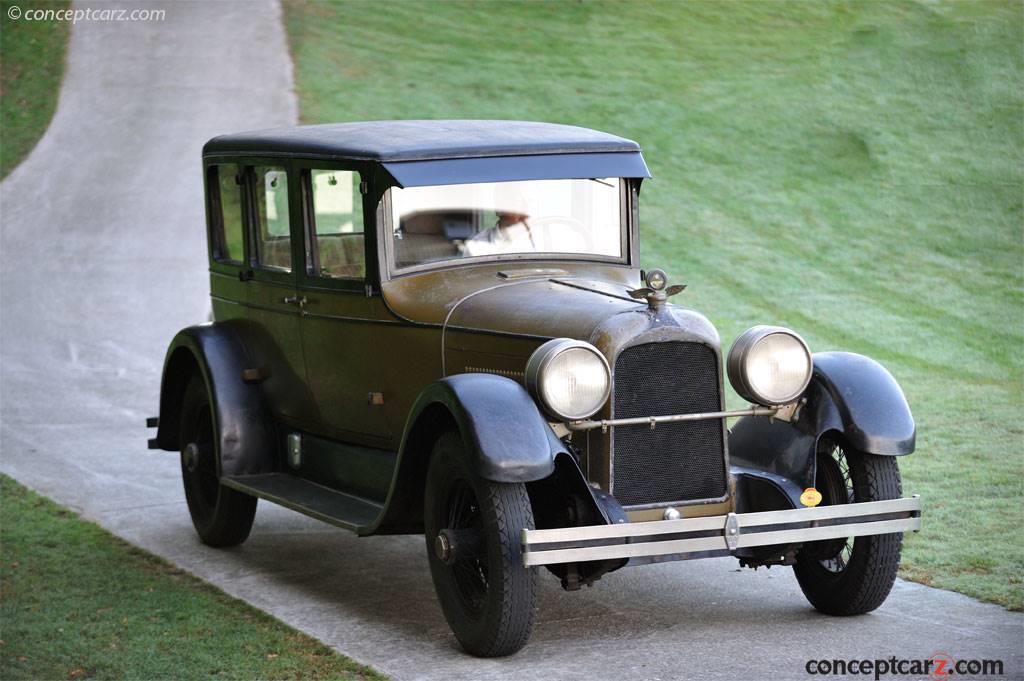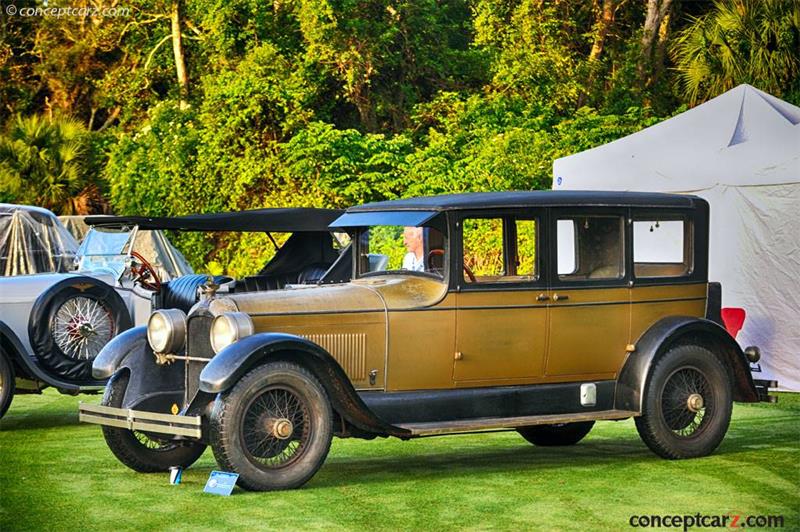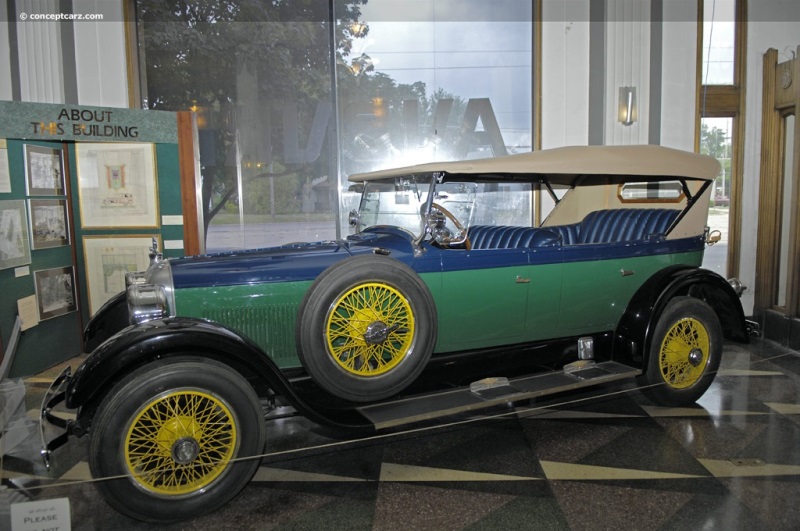1926 Duesenberg Model A Navigation
It was at the New York salon at the Hotel Commodore in November 1920 that the Duesenberg brothers displayed a passenger car bearing their name and built to their own design. Prior to this, they had birthed numerous successful racing cars and had been involved in various other road cars, with the most famous of them being the Mason and Maytag automobiles, where their career had begun. 
Phaeton by Millspaugh & Irish
View info and historyRelocating to Saint Paul, Minnesota, the brothers established the Duesenberg Motors Company in 1913. Among the mechanical ingenuity that flowed from their shop was the so-called 'walking-beam' four-cylinder engine. The design incorporated overhead valves that were horizontal instead of vertical. It used long rocker arms (rather than pushrods), also known as 'walking beams,' that stretched from the camshaft in the block up to the valve stems at the top. Above the main combustion chamber was a small chamber that housed the spark plugs which ignited the mixture that would burn downward into a leaner mixture. This configuration used less fuel and created more power, a combination that made it very successful in racing. Despite its success, the brothers failed to find profitably demanded by their New York investors, so the rights to the walking-beam four were sold to the Rochester Motor Company. They, in turn, sold versions of the engine to ReVere, RoameR, Biddie, and others. Duesenberg Automobiles and Motors Company
In 1919, the Duesenberg brothers sold their Saint Paul factories and relocated to Indianapolis, Indiana, in 1920, where they founded the Duesenberg Automobile & Motors Company (the company was incorporated in Delaware). Their first road-going automobile was the Model A. It was the first automobile in series production in the United States with a straight-eight engine and the first in series production to employ hydraulic brakes. Following numerous design changes, production commenced in 1921 and continued through 1926 (from 1921 to 1925 by the Duesenberg Automobiles and Motors Company and from 1925 to 1926 at the same factory by the restructured Duesenberg Motor Company.)The Duesenberg Automobiles and Motors Company produced and marketed the production car, while the Duesenberg Brothers Company built racing cars and engines. The Duesenberg Straight Eight
The Duesenberg Model A, officially known as the Duesenberg Straight Eight, was introduced in late 1920 in New York City. Production commenced nearly a year later due to moving the company headquarters from New Jersey to Indiana and several substantial design changes to the car. Among the most significant of these changes was abandoning the horizontal overhead valves in favor of an overhead camshaft design. Mechanical Specification
Chassis
The standard Model A (Straight Eight) chassis had a 134-inch wheelbase size, while the longer version measured 141 inches. It was a conventional pressed steel ladder frame reinforced with channel-section side members and fabricated and tubular cross members. At the front was a tubular beam axle and the rear relied on a live axle and radius rods.
7-Passenger Touring by Springfield
View info and historyThe front and rear tracks both measured 56 inches wide. The center-locking wire wheels were wrapped with 5 x 33 tires. The suspension used semi-elliptic leaf springs and Watson Stabilator dampers. Lockheed Corporation Hydraulic brakes were located on all four wheels making it the first production automobile so equipped (history records the Rickenbacker and the one-off Colonial as also sharing in this honor). The brakes on the front wheels were 16 inches in diameter. Engine
The prototype Straight Eight that was shown at the Hotel Commodore had horizontal valves of the type used in earlier Duesenberg-designed marine and racing engines.The production straight-eight-cylinder engine was formed from a cast iron block that had a detachable cast iron cylinder head, an aluminum oil pan, and an aluminum lower crankcase that ran in three main bearings. It had a shaft-driven single overhead camshaft with rockers that operated two valves per cylinder in a hemispheric combustion chamber. Early examples breathed through a single Stromberg updraft carburetor, while later examples were given a Schebler unit. The ignition was via Delco coil and breaker points.
Phaeton by Millspaugh & Irish
Chassis #: 1451
Engine #: 1453
View info and history
Auction entries : 2The engine bore measured 2.875 inches (73 mm), and the stroke was 5 inches (127 mm), resulting in a displacement size of 260 cubic inches (4.3 liters). With a standard compression ratio of five to one (5:1), the engine produced 88 horsepower at 3,600 RPM and 170 lb.-ft of torque at 1,500 RPM. Transmission
The transmission was an unsynchronized three-speed unit that was bolted to the engine. It had a single dry-plate clutch and was operated with a central shift lever. The drive shaft was enclosed in a torque tube, operated a spiral bevel drive, and drove the live rear axle.Production
The Model A was one of the most advanced automobiles on the road, and its generous platform and potent engine accommodated a variety of heavy and luxurious coachwork. Although a new company, the individuals behind the scene were highly skilled and experienced. Poised and ready for success, Model A would experience a fate similar to that of its future sibling, the famous Model J, and was a victim of market conditions. The Duesenberg Model J was introduced just prior to the onset of the Great Depression, and the Model A was introduced during a deflationary recession in the United States, United Kingdom, and other countries that lasted from January 1920 to July 1921. The luxury car market suffered, and the intended production target of 100 Model A cars per month was not achieved. It took over a year before 150 Duesenberg Straight Eights had been built, falling far short of the initial production estimates. Market conditions would improve throughout the 1920s, but Duesenberg was unable to recover and entered receivership in January 1924. Restructured into the Duesenberg Motor Company in February 1925, the company was acquired by E.L. Cord in October 1926.
Roadster by Charles G. Schutte Body Company
Chassis #: D61S
View info and historyApproximately 650 examples of the Model A were produced between 1921 and 1926. Most examples were factory-cataloged coachwork built by well-known coachbuilders such as the Fleetwood Metal Body Company of Pennsylvania, Brunn, and Millspaugh & Irish of Indianapolis.Financial success would illude the Model A, but its reputation would create a legacy, attracting the attention of E.L. Cord, who added it to his growing empire of companies. Under his direction, and with the mandate of creating a car to rival the size, power, and luxury of all other automobiles, the Model J was born. Among the Duesenberg Company's accolades were placing 10th at the 1914 Indianapolis 500 and outright wins in 1924, 1925, and 1927.
by Daniel Vaughan | Jun 2024
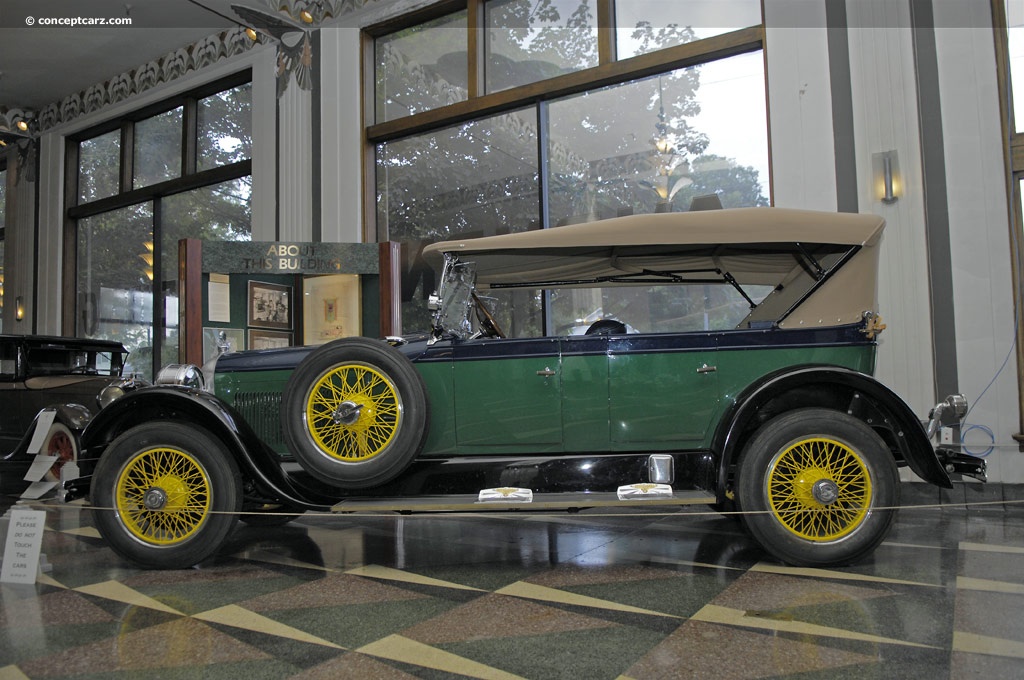
Phaeton by Millspaugh & Irish
View info and history
In 1919, the Duesenberg brothers sold their Saint Paul factories and relocated to Indianapolis, Indiana, in 1920, where they founded the Duesenberg Automobile & Motors Company (the company was incorporated in Delaware). Their first road-going automobile was the Model A. It was the first automobile in series production in the United States with a straight-eight engine and the first in series production to employ hydraulic brakes. Following numerous design changes, production commenced in 1921 and continued through 1926 (from 1921 to 1925 by the Duesenberg Automobiles and Motors Company and from 1925 to 1926 at the same factory by the restructured Duesenberg Motor Company.)The Duesenberg Automobiles and Motors Company produced and marketed the production car, while the Duesenberg Brothers Company built racing cars and engines. The Duesenberg Straight Eight
The Duesenberg Model A, officially known as the Duesenberg Straight Eight, was introduced in late 1920 in New York City. Production commenced nearly a year later due to moving the company headquarters from New Jersey to Indiana and several substantial design changes to the car. Among the most significant of these changes was abandoning the horizontal overhead valves in favor of an overhead camshaft design. Mechanical Specification
Chassis
The standard Model A (Straight Eight) chassis had a 134-inch wheelbase size, while the longer version measured 141 inches. It was a conventional pressed steel ladder frame reinforced with channel-section side members and fabricated and tubular cross members. At the front was a tubular beam axle and the rear relied on a live axle and radius rods.
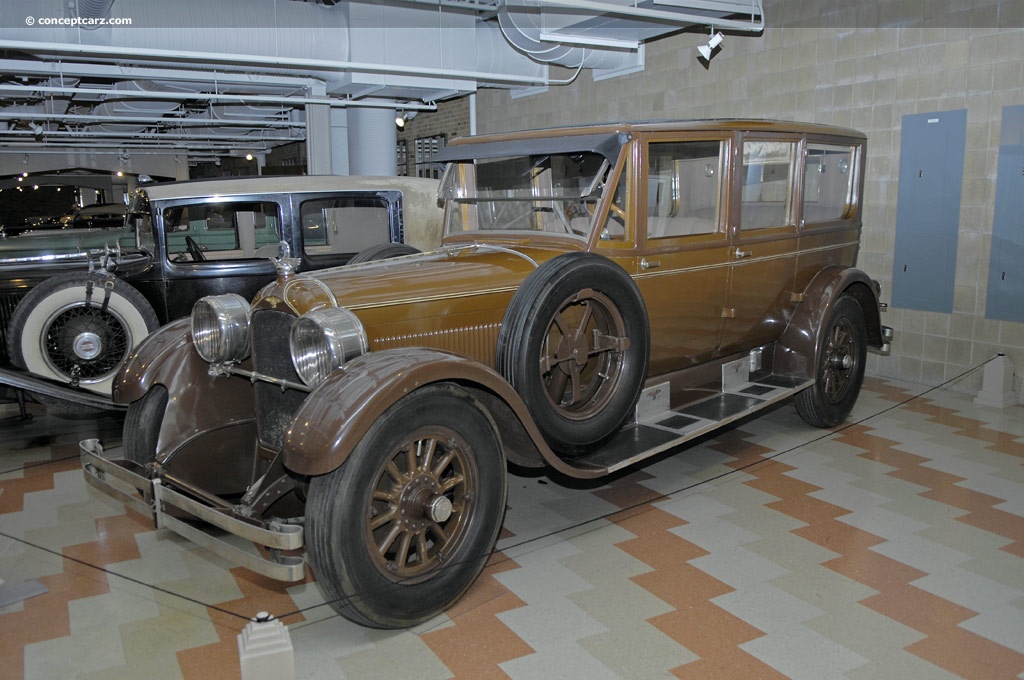
7-Passenger Touring by Springfield
View info and history
The prototype Straight Eight that was shown at the Hotel Commodore had horizontal valves of the type used in earlier Duesenberg-designed marine and racing engines.The production straight-eight-cylinder engine was formed from a cast iron block that had a detachable cast iron cylinder head, an aluminum oil pan, and an aluminum lower crankcase that ran in three main bearings. It had a shaft-driven single overhead camshaft with rockers that operated two valves per cylinder in a hemispheric combustion chamber. Early examples breathed through a single Stromberg updraft carburetor, while later examples were given a Schebler unit. The ignition was via Delco coil and breaker points.

Phaeton by Millspaugh & Irish
Chassis #: 1451
Engine #: 1453
View info and history
Auction entries : 2
The transmission was an unsynchronized three-speed unit that was bolted to the engine. It had a single dry-plate clutch and was operated with a central shift lever. The drive shaft was enclosed in a torque tube, operated a spiral bevel drive, and drove the live rear axle.Production
The Model A was one of the most advanced automobiles on the road, and its generous platform and potent engine accommodated a variety of heavy and luxurious coachwork. Although a new company, the individuals behind the scene were highly skilled and experienced. Poised and ready for success, Model A would experience a fate similar to that of its future sibling, the famous Model J, and was a victim of market conditions. The Duesenberg Model J was introduced just prior to the onset of the Great Depression, and the Model A was introduced during a deflationary recession in the United States, United Kingdom, and other countries that lasted from January 1920 to July 1921. The luxury car market suffered, and the intended production target of 100 Model A cars per month was not achieved. It took over a year before 150 Duesenberg Straight Eights had been built, falling far short of the initial production estimates. Market conditions would improve throughout the 1920s, but Duesenberg was unable to recover and entered receivership in January 1924. Restructured into the Duesenberg Motor Company in February 1925, the company was acquired by E.L. Cord in October 1926.
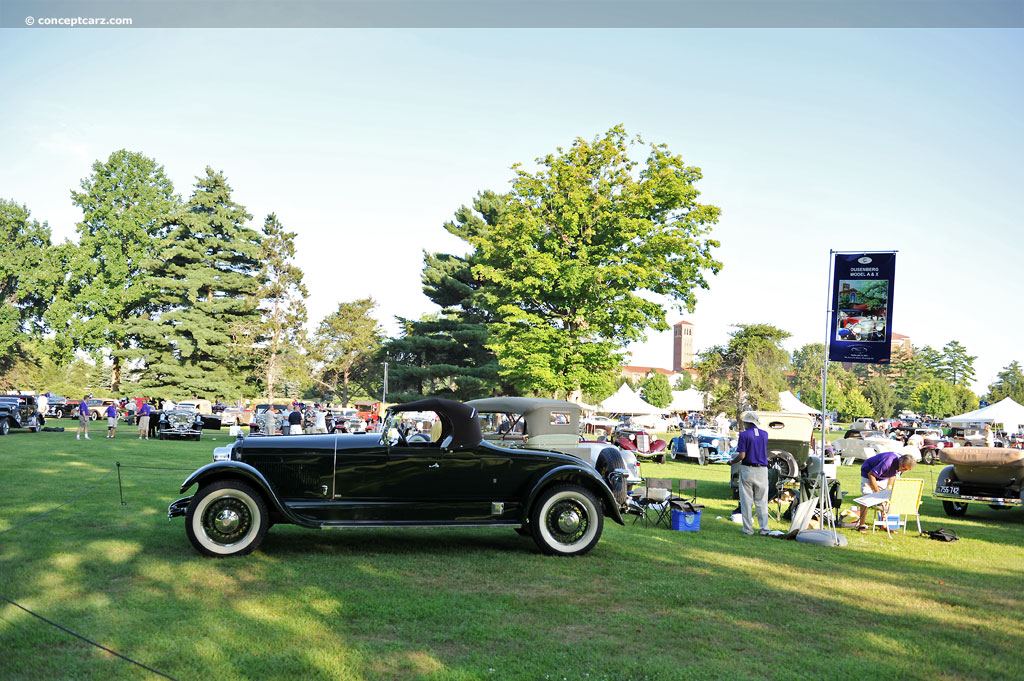
Roadster by Charles G. Schutte Body Company
Chassis #: D61S
View info and history
by Daniel Vaughan | Jun 2024
Related Reading : Duesenberg Model A History
Brothers Fred and August Duesenberg will be remembered always for their outstanding motorcars. True perfectionists and genius engineers, the Duesenbergs were responsible for some of the very best racing and road-going cars in the world from the building of their first cars in 1913 until the last automobiles to bare their name was produced in 1937. But while all Duesenberg cars were outstanding....
Continue Reading >>
Continue Reading >>
- 1926 Duesenberg Model A Menu
- Article
- Image gallery
- Valuation
- Specifications
- Profiles
Duesenberg
Similar Automakers
Similarly Priced Vehicles
1926 Duesenberg Model A Vehicle Profiles
Recent Vehicle Additions
Performance and Specification Comparison
Price Comparison
Model A Specification Comparison by Year
Year
Production
Wheelbase
Engine
Prices
Related Automotive News

Gooding & Company Looks Toward Pebble Beach with Stunning Selection of Historic Prewar Classics
Highlights include a top-of-the-line 1930 Duesenberg Model J Disappearing-Top Convertible Coupe, a Grand Prix-winning 1929 Bugatti Type 35B, a well-documented 1914 Stutz 4E Bearcat, and an opulent 1910 Rolls-Royce 4050 HP Silver Ghost Pullman Limousine.
As...

63rd Pebble Beach Concours d'Elegance Names 1934 Packard 'Best of Show'
The competition showcased 248 cars, including 48 from abroad
PEBBLE BEACH, Calif. (August 18, 2013) -- A 1934 Packard 1108 Twelve Dietrich Convertible Victoria owned by Joseph and Margie Cassini III of West Orange, New Jersey, was named Best...

DODGE ANNOUNCES PRICING FOR NEW 2014 DODGE DURANGO
Best-equipped Seven Passenger SUV Loaded With Advanced Technology, Efficiency, Performance and Style for a Starting U.S. MSRP Less Than %2430,000.
The new Dodge Durango features a slew of new standard features for 2014, including a new standard...

Microcar Collection To Be Giants Of 7Th Annual Barrington Concours D'Elegance
BARRINGTON, ILL. – June 27, 2013 – The 7th Annual Barrington Concours dElegance will show a group of distinctive, fanciful Microcars on the Concours field during the July 12-14, 2013 weekend, at the Makray Memorial Golf Club in Barrington, Ill....

ALL-NEW 2014 JEEP CHEROKEE TO START AT $22,995
Jeep® raises the bar with legendary benchmark 4x4 capability, world-class on-road dynamics, fuel economy of more than 30 mpg, modern and progressive new design, world-class craftsmanship, and an array of advanced safety and technology features
All-...
